CAM101A: Engaging in Discussions on History & Philosophy of CAM
VerifiedAdded on 2023/04/19
|7
|1537
|254
Discussion Board Post
AI Summary
This assignment comprises a series of discussion posts focusing on key aspects of complementary and alternative medicine (CAM). It begins with an exploration of vitalism, tracing its origins to Johann Friedrich Blumenbach and its emphasis on the body's innate self-healing capabilities. The discussion then shifts to naturopathy, examining its holistic approach to healing using natural remedies like acupuncture, herbs, and nutritional counseling, particularly in disaster relief scenarios. Further posts delve into the nursing code of ethics in Australia, highlighting its principles of respect, quality healthcare, and evidence-based practice. Finally, osteopathy is discussed, contrasting it with allopathic medicine and emphasizing its focus on the body's self-regulation and interconnectedness of structure and function. The assignment references several scholarly articles to support its analysis of each topic.

Running Head: ASSIGNMENT
Assignment
Students Name
University affiliation
Date
Assignment
Students Name
University affiliation
Date
Paraphrase This Document
Need a fresh take? Get an instant paraphrase of this document with our AI Paraphraser
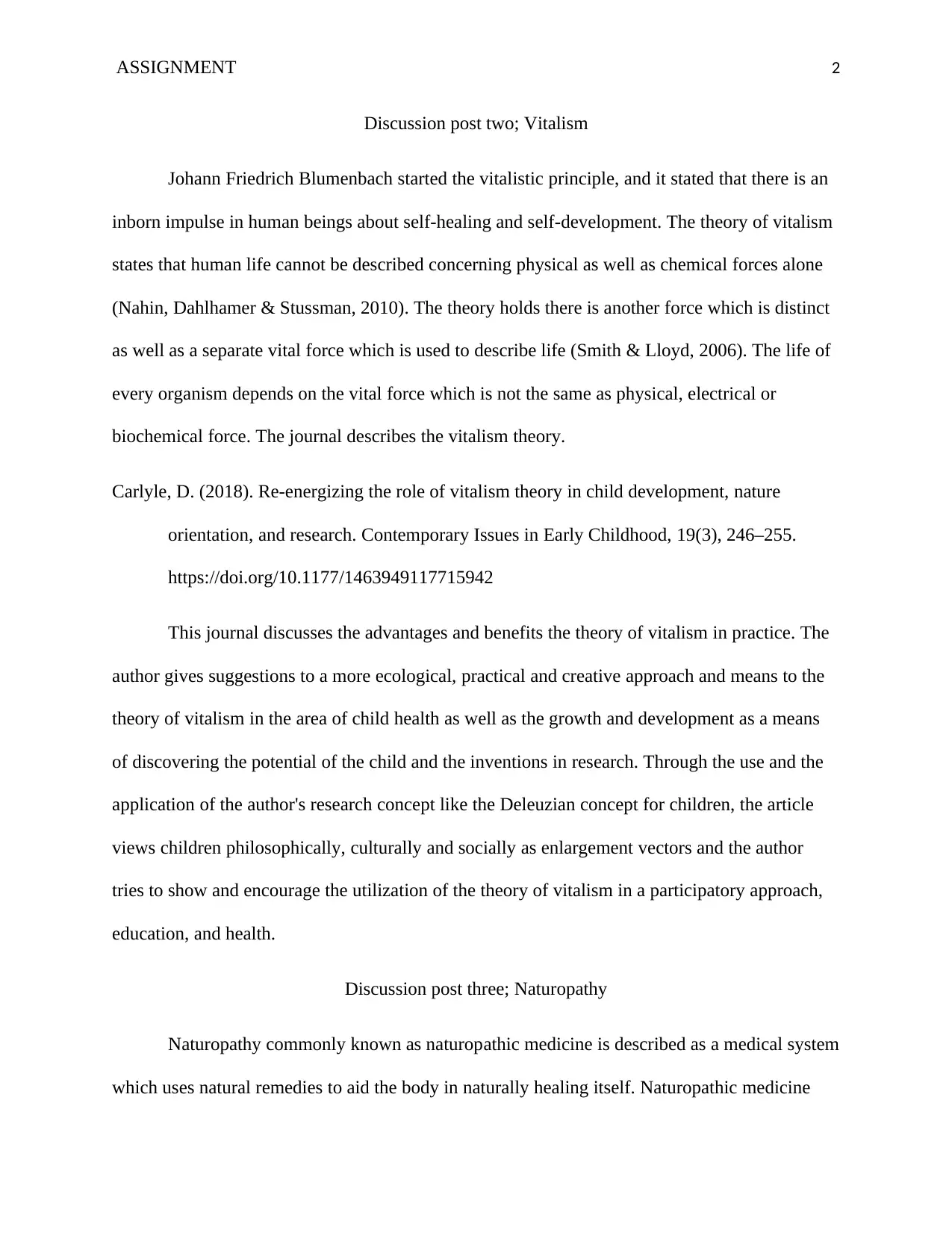
ASSIGNMENT 2
Discussion post two; Vitalism
Johann Friedrich Blumenbach started the vitalistic principle, and it stated that there is an
inborn impulse in human beings about self-healing and self-development. The theory of vitalism
states that human life cannot be described concerning physical as well as chemical forces alone
(Nahin, Dahlhamer & Stussman, 2010). The theory holds there is another force which is distinct
as well as a separate vital force which is used to describe life (Smith & Lloyd, 2006). The life of
every organism depends on the vital force which is not the same as physical, electrical or
biochemical force. The journal describes the vitalism theory.
Carlyle, D. (2018). Re-energizing the role of vitalism theory in child development, nature
orientation, and research. Contemporary Issues in Early Childhood, 19(3), 246–255.
https://doi.org/10.1177/1463949117715942
This journal discusses the advantages and benefits the theory of vitalism in practice. The
author gives suggestions to a more ecological, practical and creative approach and means to the
theory of vitalism in the area of child health as well as the growth and development as a means
of discovering the potential of the child and the inventions in research. Through the use and the
application of the author's research concept like the Deleuzian concept for children, the article
views children philosophically, culturally and socially as enlargement vectors and the author
tries to show and encourage the utilization of the theory of vitalism in a participatory approach,
education, and health.
Discussion post three; Naturopathy
Naturopathy commonly known as naturopathic medicine is described as a medical system
which uses natural remedies to aid the body in naturally healing itself. Naturopathic medicine
Discussion post two; Vitalism
Johann Friedrich Blumenbach started the vitalistic principle, and it stated that there is an
inborn impulse in human beings about self-healing and self-development. The theory of vitalism
states that human life cannot be described concerning physical as well as chemical forces alone
(Nahin, Dahlhamer & Stussman, 2010). The theory holds there is another force which is distinct
as well as a separate vital force which is used to describe life (Smith & Lloyd, 2006). The life of
every organism depends on the vital force which is not the same as physical, electrical or
biochemical force. The journal describes the vitalism theory.
Carlyle, D. (2018). Re-energizing the role of vitalism theory in child development, nature
orientation, and research. Contemporary Issues in Early Childhood, 19(3), 246–255.
https://doi.org/10.1177/1463949117715942
This journal discusses the advantages and benefits the theory of vitalism in practice. The
author gives suggestions to a more ecological, practical and creative approach and means to the
theory of vitalism in the area of child health as well as the growth and development as a means
of discovering the potential of the child and the inventions in research. Through the use and the
application of the author's research concept like the Deleuzian concept for children, the article
views children philosophically, culturally and socially as enlargement vectors and the author
tries to show and encourage the utilization of the theory of vitalism in a participatory approach,
education, and health.
Discussion post three; Naturopathy
Naturopathy commonly known as naturopathic medicine is described as a medical system
which uses natural remedies to aid the body in naturally healing itself. Naturopathic medicine
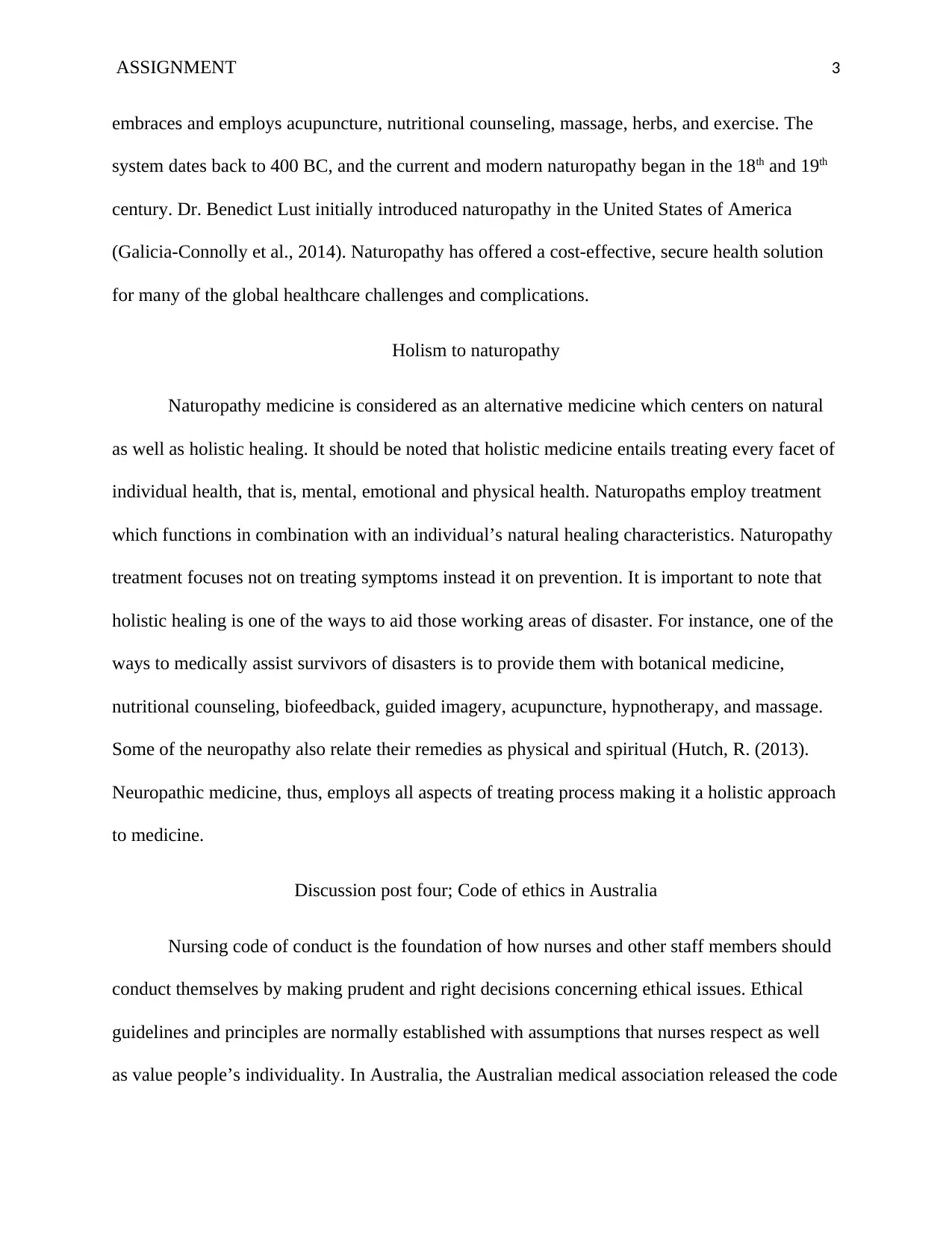
ASSIGNMENT 3
embraces and employs acupuncture, nutritional counseling, massage, herbs, and exercise. The
system dates back to 400 BC, and the current and modern naturopathy began in the 18th and 19th
century. Dr. Benedict Lust initially introduced naturopathy in the United States of America
(Galicia-Connolly et al., 2014). Naturopathy has offered a cost-effective, secure health solution
for many of the global healthcare challenges and complications.
Holism to naturopathy
Naturopathy medicine is considered as an alternative medicine which centers on natural
as well as holistic healing. It should be noted that holistic medicine entails treating every facet of
individual health, that is, mental, emotional and physical health. Naturopaths employ treatment
which functions in combination with an individual’s natural healing characteristics. Naturopathy
treatment focuses not on treating symptoms instead it on prevention. It is important to note that
holistic healing is one of the ways to aid those working areas of disaster. For instance, one of the
ways to medically assist survivors of disasters is to provide them with botanical medicine,
nutritional counseling, biofeedback, guided imagery, acupuncture, hypnotherapy, and massage.
Some of the neuropathy also relate their remedies as physical and spiritual (Hutch, R. (2013).
Neuropathic medicine, thus, employs all aspects of treating process making it a holistic approach
to medicine.
Discussion post four; Code of ethics in Australia
Nursing code of conduct is the foundation of how nurses and other staff members should
conduct themselves by making prudent and right decisions concerning ethical issues. Ethical
guidelines and principles are normally established with assumptions that nurses respect as well
as value people’s individuality. In Australia, the Australian medical association released the code
embraces and employs acupuncture, nutritional counseling, massage, herbs, and exercise. The
system dates back to 400 BC, and the current and modern naturopathy began in the 18th and 19th
century. Dr. Benedict Lust initially introduced naturopathy in the United States of America
(Galicia-Connolly et al., 2014). Naturopathy has offered a cost-effective, secure health solution
for many of the global healthcare challenges and complications.
Holism to naturopathy
Naturopathy medicine is considered as an alternative medicine which centers on natural
as well as holistic healing. It should be noted that holistic medicine entails treating every facet of
individual health, that is, mental, emotional and physical health. Naturopaths employ treatment
which functions in combination with an individual’s natural healing characteristics. Naturopathy
treatment focuses not on treating symptoms instead it on prevention. It is important to note that
holistic healing is one of the ways to aid those working areas of disaster. For instance, one of the
ways to medically assist survivors of disasters is to provide them with botanical medicine,
nutritional counseling, biofeedback, guided imagery, acupuncture, hypnotherapy, and massage.
Some of the neuropathy also relate their remedies as physical and spiritual (Hutch, R. (2013).
Neuropathic medicine, thus, employs all aspects of treating process making it a holistic approach
to medicine.
Discussion post four; Code of ethics in Australia
Nursing code of conduct is the foundation of how nurses and other staff members should
conduct themselves by making prudent and right decisions concerning ethical issues. Ethical
guidelines and principles are normally established with assumptions that nurses respect as well
as value people’s individuality. In Australia, the Australian medical association released the code
⊘ This is a preview!⊘
Do you want full access?
Subscribe today to unlock all pages.

Trusted by 1+ million students worldwide
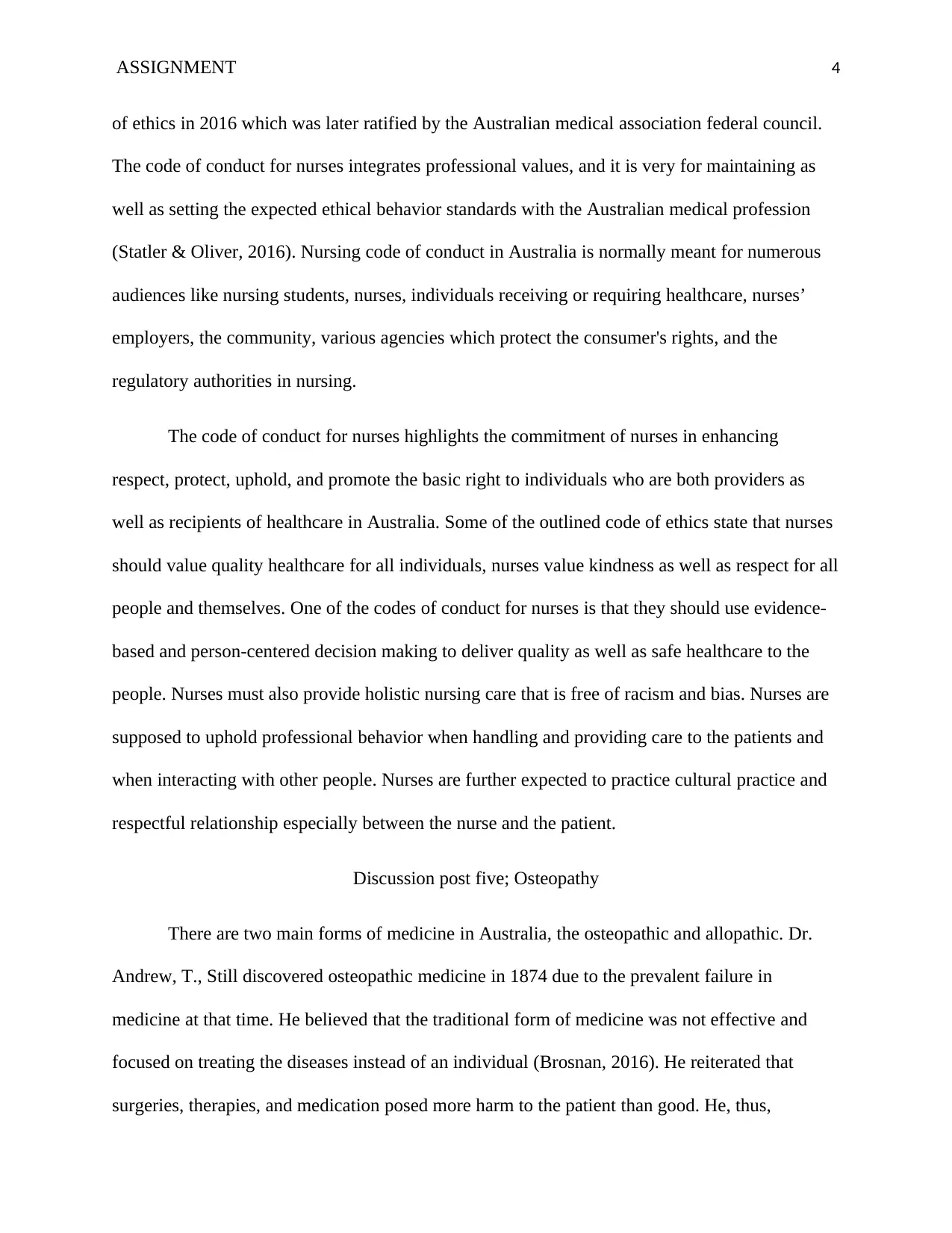
ASSIGNMENT 4
of ethics in 2016 which was later ratified by the Australian medical association federal council.
The code of conduct for nurses integrates professional values, and it is very for maintaining as
well as setting the expected ethical behavior standards with the Australian medical profession
(Statler & Oliver, 2016). Nursing code of conduct in Australia is normally meant for numerous
audiences like nursing students, nurses, individuals receiving or requiring healthcare, nurses’
employers, the community, various agencies which protect the consumer's rights, and the
regulatory authorities in nursing.
The code of conduct for nurses highlights the commitment of nurses in enhancing
respect, protect, uphold, and promote the basic right to individuals who are both providers as
well as recipients of healthcare in Australia. Some of the outlined code of ethics state that nurses
should value quality healthcare for all individuals, nurses value kindness as well as respect for all
people and themselves. One of the codes of conduct for nurses is that they should use evidence-
based and person-centered decision making to deliver quality as well as safe healthcare to the
people. Nurses must also provide holistic nursing care that is free of racism and bias. Nurses are
supposed to uphold professional behavior when handling and providing care to the patients and
when interacting with other people. Nurses are further expected to practice cultural practice and
respectful relationship especially between the nurse and the patient.
Discussion post five; Osteopathy
There are two main forms of medicine in Australia, the osteopathic and allopathic. Dr.
Andrew, T., Still discovered osteopathic medicine in 1874 due to the prevalent failure in
medicine at that time. He believed that the traditional form of medicine was not effective and
focused on treating the diseases instead of an individual (Brosnan, 2016). He reiterated that
surgeries, therapies, and medication posed more harm to the patient than good. He, thus,
of ethics in 2016 which was later ratified by the Australian medical association federal council.
The code of conduct for nurses integrates professional values, and it is very for maintaining as
well as setting the expected ethical behavior standards with the Australian medical profession
(Statler & Oliver, 2016). Nursing code of conduct in Australia is normally meant for numerous
audiences like nursing students, nurses, individuals receiving or requiring healthcare, nurses’
employers, the community, various agencies which protect the consumer's rights, and the
regulatory authorities in nursing.
The code of conduct for nurses highlights the commitment of nurses in enhancing
respect, protect, uphold, and promote the basic right to individuals who are both providers as
well as recipients of healthcare in Australia. Some of the outlined code of ethics state that nurses
should value quality healthcare for all individuals, nurses value kindness as well as respect for all
people and themselves. One of the codes of conduct for nurses is that they should use evidence-
based and person-centered decision making to deliver quality as well as safe healthcare to the
people. Nurses must also provide holistic nursing care that is free of racism and bias. Nurses are
supposed to uphold professional behavior when handling and providing care to the patients and
when interacting with other people. Nurses are further expected to practice cultural practice and
respectful relationship especially between the nurse and the patient.
Discussion post five; Osteopathy
There are two main forms of medicine in Australia, the osteopathic and allopathic. Dr.
Andrew, T., Still discovered osteopathic medicine in 1874 due to the prevalent failure in
medicine at that time. He believed that the traditional form of medicine was not effective and
focused on treating the diseases instead of an individual (Brosnan, 2016). He reiterated that
surgeries, therapies, and medication posed more harm to the patient than good. He, thus,
Paraphrase This Document
Need a fresh take? Get an instant paraphrase of this document with our AI Paraphraser
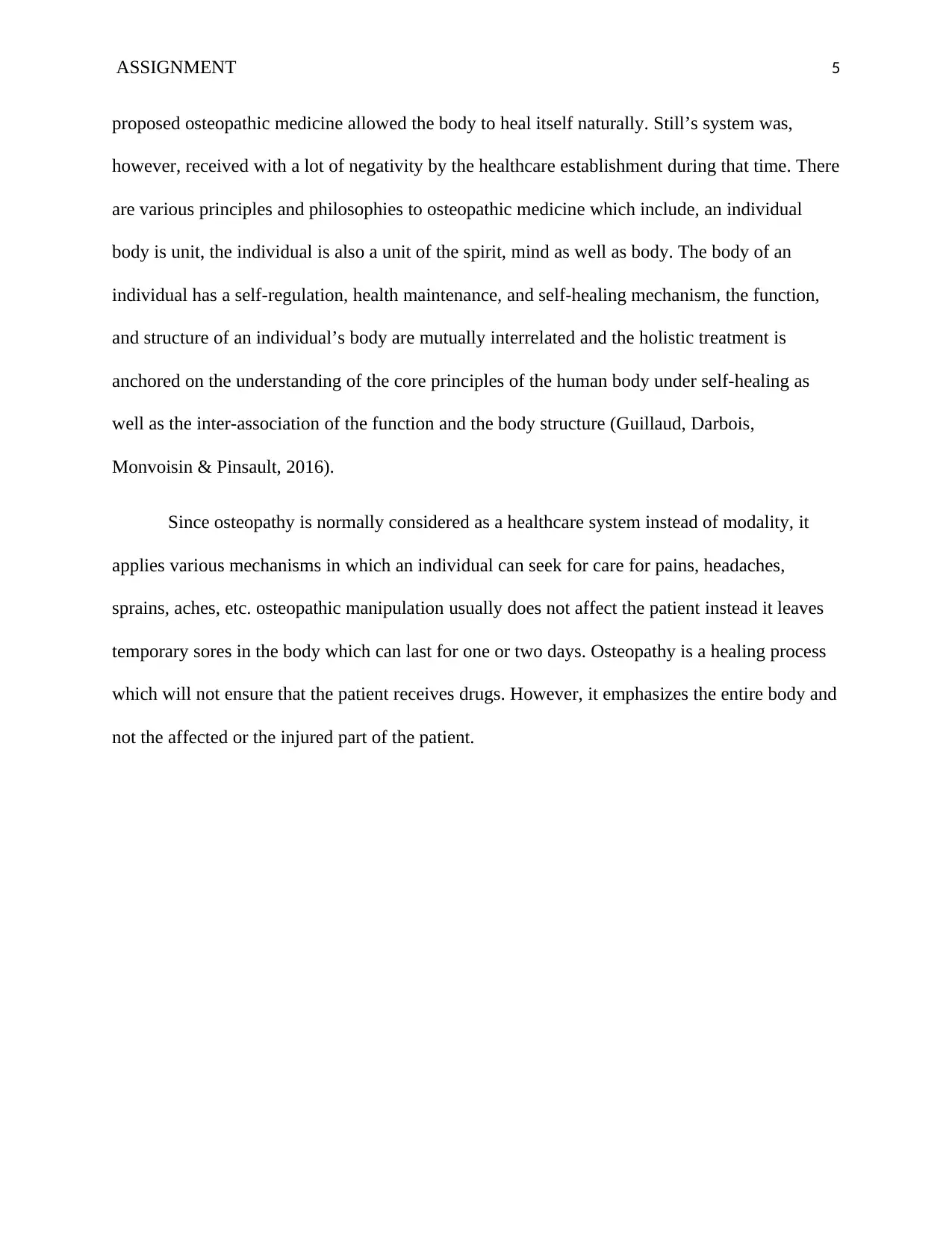
ASSIGNMENT 5
proposed osteopathic medicine allowed the body to heal itself naturally. Still’s system was,
however, received with a lot of negativity by the healthcare establishment during that time. There
are various principles and philosophies to osteopathic medicine which include, an individual
body is unit, the individual is also a unit of the spirit, mind as well as body. The body of an
individual has a self-regulation, health maintenance, and self-healing mechanism, the function,
and structure of an individual’s body are mutually interrelated and the holistic treatment is
anchored on the understanding of the core principles of the human body under self-healing as
well as the inter-association of the function and the body structure (Guillaud, Darbois,
Monvoisin & Pinsault, 2016).
Since osteopathy is normally considered as a healthcare system instead of modality, it
applies various mechanisms in which an individual can seek for care for pains, headaches,
sprains, aches, etc. osteopathic manipulation usually does not affect the patient instead it leaves
temporary sores in the body which can last for one or two days. Osteopathy is a healing process
which will not ensure that the patient receives drugs. However, it emphasizes the entire body and
not the affected or the injured part of the patient.
proposed osteopathic medicine allowed the body to heal itself naturally. Still’s system was,
however, received with a lot of negativity by the healthcare establishment during that time. There
are various principles and philosophies to osteopathic medicine which include, an individual
body is unit, the individual is also a unit of the spirit, mind as well as body. The body of an
individual has a self-regulation, health maintenance, and self-healing mechanism, the function,
and structure of an individual’s body are mutually interrelated and the holistic treatment is
anchored on the understanding of the core principles of the human body under self-healing as
well as the inter-association of the function and the body structure (Guillaud, Darbois,
Monvoisin & Pinsault, 2016).
Since osteopathy is normally considered as a healthcare system instead of modality, it
applies various mechanisms in which an individual can seek for care for pains, headaches,
sprains, aches, etc. osteopathic manipulation usually does not affect the patient instead it leaves
temporary sores in the body which can last for one or two days. Osteopathy is a healing process
which will not ensure that the patient receives drugs. However, it emphasizes the entire body and
not the affected or the injured part of the patient.
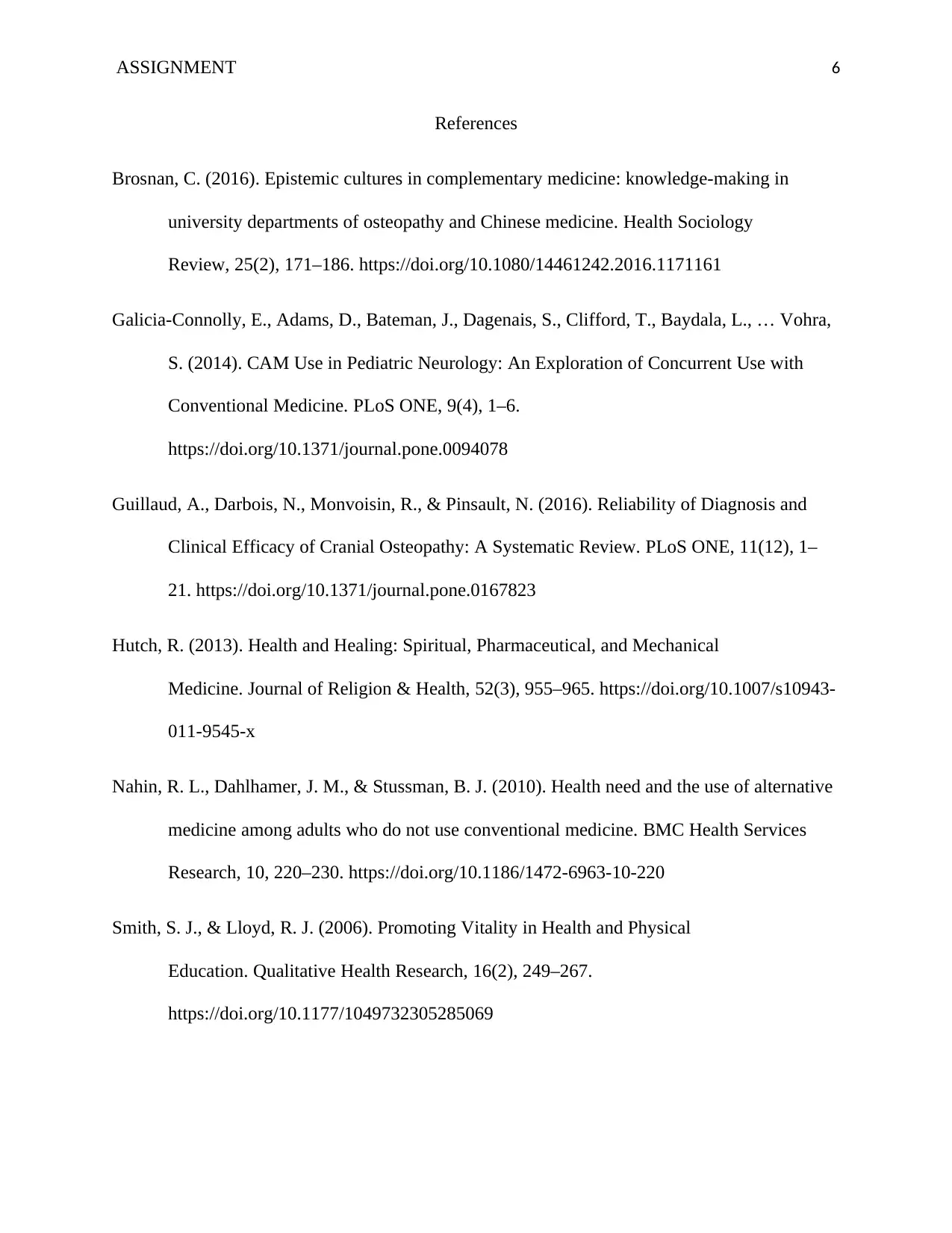
ASSIGNMENT 6
References
Brosnan, C. (2016). Epistemic cultures in complementary medicine: knowledge-making in
university departments of osteopathy and Chinese medicine. Health Sociology
Review, 25(2), 171–186. https://doi.org/10.1080/14461242.2016.1171161
Galicia-Connolly, E., Adams, D., Bateman, J., Dagenais, S., Clifford, T., Baydala, L., … Vohra,
S. (2014). CAM Use in Pediatric Neurology: An Exploration of Concurrent Use with
Conventional Medicine. PLoS ONE, 9(4), 1–6.
https://doi.org/10.1371/journal.pone.0094078
Guillaud, A., Darbois, N., Monvoisin, R., & Pinsault, N. (2016). Reliability of Diagnosis and
Clinical Efficacy of Cranial Osteopathy: A Systematic Review. PLoS ONE, 11(12), 1–
21. https://doi.org/10.1371/journal.pone.0167823
Hutch, R. (2013). Health and Healing: Spiritual, Pharmaceutical, and Mechanical
Medicine. Journal of Religion & Health, 52(3), 955–965. https://doi.org/10.1007/s10943-
011-9545-x
Nahin, R. L., Dahlhamer, J. M., & Stussman, B. J. (2010). Health need and the use of alternative
medicine among adults who do not use conventional medicine. BMC Health Services
Research, 10, 220–230. https://doi.org/10.1186/1472-6963-10-220
Smith, S. J., & Lloyd, R. J. (2006). Promoting Vitality in Health and Physical
Education. Qualitative Health Research, 16(2), 249–267.
https://doi.org/10.1177/1049732305285069
References
Brosnan, C. (2016). Epistemic cultures in complementary medicine: knowledge-making in
university departments of osteopathy and Chinese medicine. Health Sociology
Review, 25(2), 171–186. https://doi.org/10.1080/14461242.2016.1171161
Galicia-Connolly, E., Adams, D., Bateman, J., Dagenais, S., Clifford, T., Baydala, L., … Vohra,
S. (2014). CAM Use in Pediatric Neurology: An Exploration of Concurrent Use with
Conventional Medicine. PLoS ONE, 9(4), 1–6.
https://doi.org/10.1371/journal.pone.0094078
Guillaud, A., Darbois, N., Monvoisin, R., & Pinsault, N. (2016). Reliability of Diagnosis and
Clinical Efficacy of Cranial Osteopathy: A Systematic Review. PLoS ONE, 11(12), 1–
21. https://doi.org/10.1371/journal.pone.0167823
Hutch, R. (2013). Health and Healing: Spiritual, Pharmaceutical, and Mechanical
Medicine. Journal of Religion & Health, 52(3), 955–965. https://doi.org/10.1007/s10943-
011-9545-x
Nahin, R. L., Dahlhamer, J. M., & Stussman, B. J. (2010). Health need and the use of alternative
medicine among adults who do not use conventional medicine. BMC Health Services
Research, 10, 220–230. https://doi.org/10.1186/1472-6963-10-220
Smith, S. J., & Lloyd, R. J. (2006). Promoting Vitality in Health and Physical
Education. Qualitative Health Research, 16(2), 249–267.
https://doi.org/10.1177/1049732305285069
⊘ This is a preview!⊘
Do you want full access?
Subscribe today to unlock all pages.

Trusted by 1+ million students worldwide
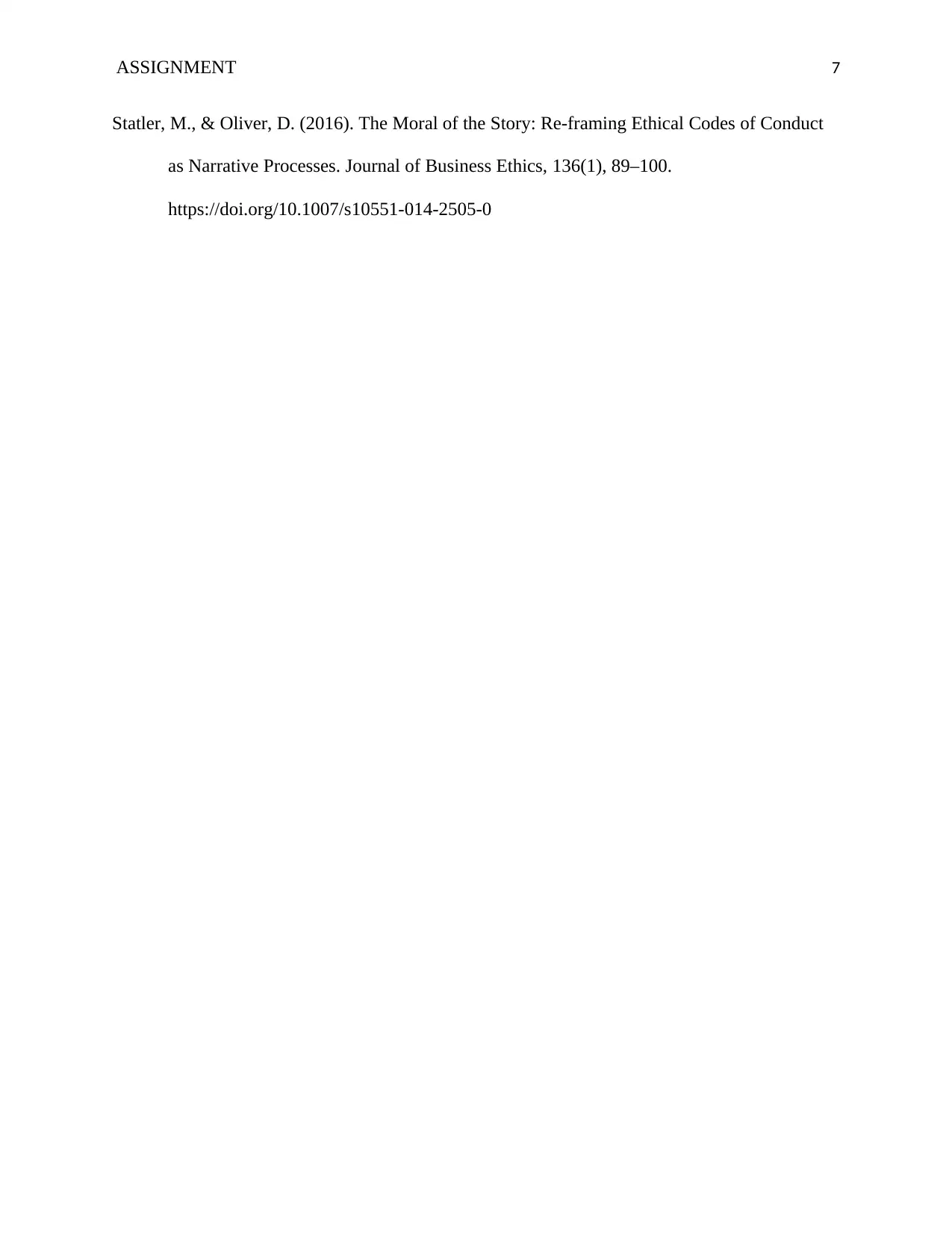
ASSIGNMENT 7
Statler, M., & Oliver, D. (2016). The Moral of the Story: Re-framing Ethical Codes of Conduct
as Narrative Processes. Journal of Business Ethics, 136(1), 89–100.
https://doi.org/10.1007/s10551-014-2505-0
Statler, M., & Oliver, D. (2016). The Moral of the Story: Re-framing Ethical Codes of Conduct
as Narrative Processes. Journal of Business Ethics, 136(1), 89–100.
https://doi.org/10.1007/s10551-014-2505-0
1 out of 7
Related Documents
Your All-in-One AI-Powered Toolkit for Academic Success.
+13062052269
info@desklib.com
Available 24*7 on WhatsApp / Email
![[object Object]](/_next/static/media/star-bottom.7253800d.svg)
Unlock your academic potential
Copyright © 2020–2025 A2Z Services. All Rights Reserved. Developed and managed by ZUCOL.





